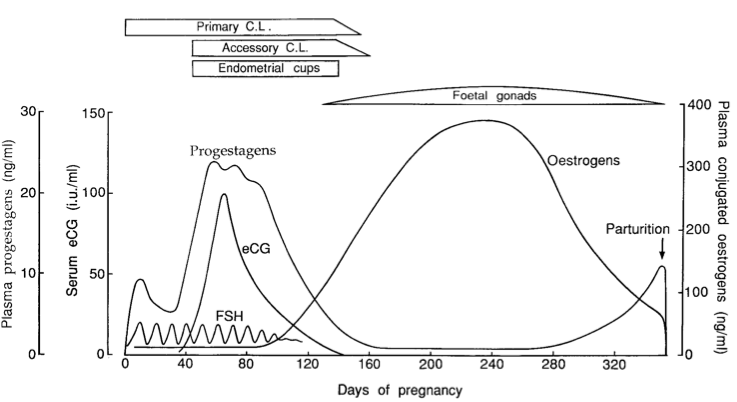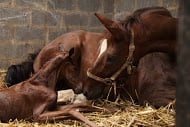
In our newsletter last month, we talked about getting organized and ready for foaling out your mare (click here for this news article). Being prepared for the foaling process is of paramount importance, in order to have an enjoyable and successful outcome for the mare, foal, breeders, owners, and attendants. As you are preparing your barn for the foaling, don’t forget that the mare has a chorus of events taking place internally to prepare her body for parturition, transition to lactation, and uterine involution. Whether these events are noticeable or not, they are a necessity for the proper progression of labor and delivery. In our blog article this month Dr. Scofield reviews the stages of parturition and summarizes the hormonal events that are occurring with your mare during this incredible physiological process.
 The horse is a seasonal breeder meaning that natural mating occurs during certain times of the year to ensure that the timing of birth is optimal for survival with regard to ambient temperature, food and water availability, and even changes in the predation behaviors of other species. Seasonal breeders are controlled by the length of daylight, i.e. the photoperiod, and can be divided into long day breeders, e.g. the horse, that start cycling when the days get longer (spring) and short day breeders, e.g. deer and some breeds of small ruminants, that start cycling when the days get shorter (fall). The length of photoperiod can be manipulated in order to hasten the onset of the breeding season. This is a popular management technique used in many breeds, so foals can be born as close to the standardized January 1st birth date as possible. It is also common with show or halter horses, with the goal being to maximize maturity for age determined competition.
The horse is a seasonal breeder meaning that natural mating occurs during certain times of the year to ensure that the timing of birth is optimal for survival with regard to ambient temperature, food and water availability, and even changes in the predation behaviors of other species. Seasonal breeders are controlled by the length of daylight, i.e. the photoperiod, and can be divided into long day breeders, e.g. the horse, that start cycling when the days get longer (spring) and short day breeders, e.g. deer and some breeds of small ruminants, that start cycling when the days get shorter (fall). The length of photoperiod can be manipulated in order to hasten the onset of the breeding season. This is a popular management technique used in many breeds, so foals can be born as close to the standardized January 1st birth date as possible. It is also common with show or halter horses, with the goal being to maximize maturity for age determined competition.




